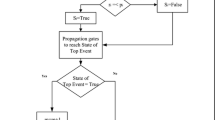Abstract
In petrochemical plant, the in-operation repairing is usually a repairing strategy with pressured inoperation repairing for avoiding huge economic losses caused by unplanned shutdown when some slight local leakage happens in pipes. This paper studies the effects of repairing strategies on the failure probability of the pipe systems in process industries based on the time-average fault tree approach, especially the in-operation repairing strategies including pressured in-operation repairing activities. The fault tree model can predict the effect of different repairing plans on the pipe failure probability, which is significant to the optimization of the repairing plans. At first pipes are distinguished into four states in this model, i.e., successive state, flaw state, leakage state and failure state. Then the fault tree approach, which is usually applied in the studies of dynamic equipment, is adopted to model the pipe failure. Moreover, the effect of pressured in-operation repairing is also considered in the model. In addition, this paper proposes a series of time-average parameters of the fault tree model, all of which are used to calculate node parameters of the fault tree model. At last, a practical case is calculated based on the fault tree model in a repairing activity of pipe thinning.
Similar content being viewed by others
References
American Petroleum Institute. API 581 Risk-Based Inspection Base Resource Document[S]. 2000.
American Petroleum Institute. API 581 Risk-Based Inspection Technology[S]. 2008.
Fleming K N. Piping System Reliability and Failure Rate Estimation Models for Use in Risk Informed In-Service Inspection Applications[M]. EPRI TR-110161. Prepared by ERIN Engineering and Research Inc. for EPRI, 1998.
Fleming K N, Hutchinson J J. Risk informed in-service inspection of the ComEd nuclear plants[C]. In: Proceedings of PSAM 5, 1999.
Gosselin S R, Fleming K N. Evaluation of pipe failure potential via degradation mechanism assessment[C]. In: Proceedings of the Fifth International Conference on Nuclear Engineering, ICONE 5. Nice, France, 1997. 236.
Chapman O J V, Fabbri L. Discussion Document on Risk Informed In-Service Inspection of Nuclear Power Plants in Europe[R]. ENIQ Report No. 23, JRC-Petten, EUR 19742/EN. The Netherlands, European Commission, DGJRC-Institute for Advanced Materials, 2000.
Fleming K N, Lydell B O Y. Database development and uncertainty treatment for estimating pipe failure rates and rupture frequencies[J]. Reliability Engineering and System Safety, 2004, 86(3): 227–246.
van Noortwijk J M, Cooke R M, Kok M. A Bayesian failure model based on isotropic deterioration[J]. European Journal of Operational Research, 1995, 82(2): 270–282.
van Noortwijk J M, van der Weide J A M, Kallen M J et al. Gamma processes and peaks-over-threshold distributions for time-dependent reliability[J]. Reliability Engineering and System Safety, 2007, 92(12): 1651–1658.
van Noortwijk J M, Klatter H E. Optimal inspection decisions for the block mats of the Eastern-Scheldt barrier[J]. Reliability Engineering and System Safety, 1999, 65(3): 203–211.
Speijker L J P, van Noortwijk J M, Kok M et al. Optimal maintenance decisions for dikes[J]. Probability in the Engineering and Informational Sciences, 2000, 14: 101–121.
Kallen M J, van Noortwijk J M. Optimal maintenance decisions under imperfect inspection[J]. Reliability Engineering and System Safety, 2005, 90(2/3): 177–185.
Xing Leiming, Fleming K N, Loh W T. Comparison of Markov model and fault tree approach in determining initiating event frequency for systems with two train configurations[ J]. Reliability Engineering and System Safety, 1996, 53(1): 17–29.
Fleming K N. Markov models for evaluating risk-informed in-service inspection strategies for nuclear power plant piping systems[J]. Reliability Engineering and System Safety, 2004, 83(1): 27–45.
Hu Haijun, Cheng Guangxu, Li Yun et al. Risk-based maintenance strategy and its applications in a petrochemical reforming reaction system[J]. Journal of Loss Prevention in the Process Industries, 2009, 22(4): 392–397.
Author information
Authors and Affiliations
Corresponding author
Additional information
Supported by National Science and Technology Pillar Program in the Twelfth Five-Year Plan (No. 2011BAK06B02) and National Basic Research Program of China (“973” Program, No. 2012CB026000).
Cong Guangpei, born in 1979, male, doctorate student.
Rights and permissions
About this article
Cite this article
Cong, G., Gao, J., Yang, J. et al. Risk assessment based on fault tree analysis for damaged pipe repair during operation in petrochemical plant. Trans. Tianjin Univ. 19, 70–78 (2013). https://doi.org/10.1007/s12209-013-1900-4
Accepted:
Published:
Issue Date:
DOI: https://doi.org/10.1007/s12209-013-1900-4




